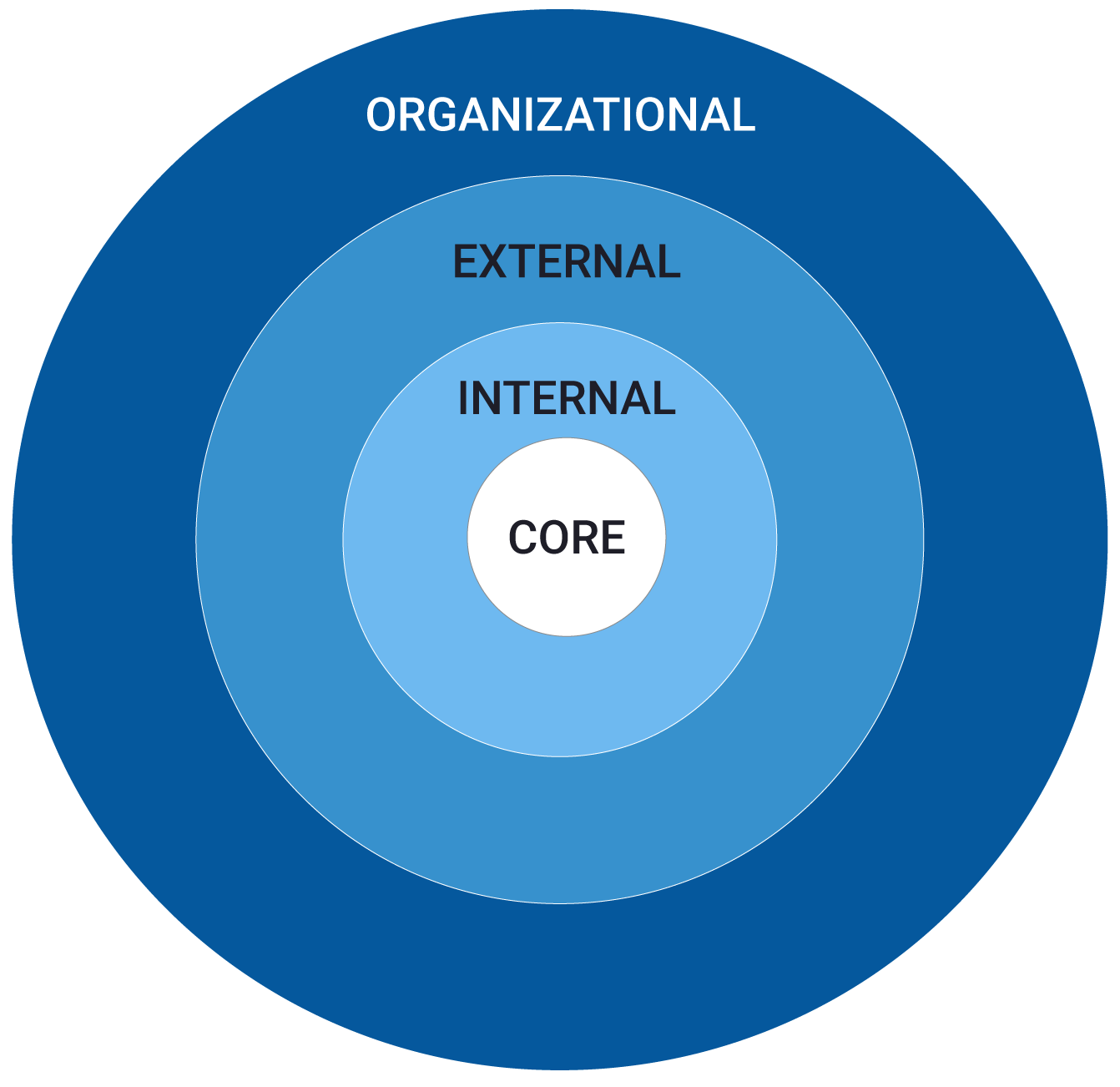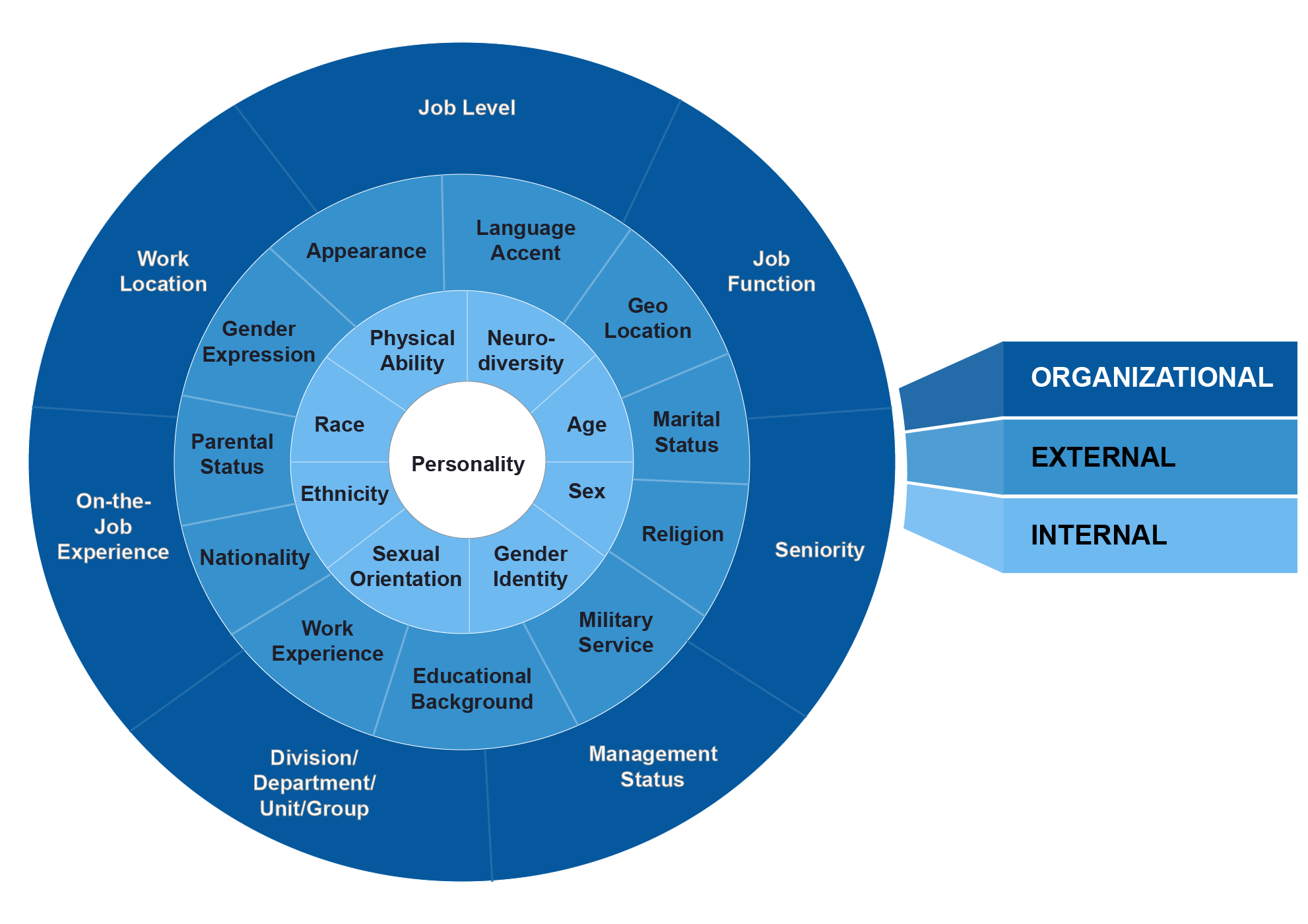


Diversity in the workplace goes beyond just race or gender—it includes a wide range of differences, from cultural backgrounds and communication styles to ability and work experiences. These differences shape how employees collaborate, solve problems, and contribute to an organization’s success.
Being aware of the various types of diversity—such as cultural, generational, neurodiversity, and more—helps teams work more effectively together. When leaders, managers, and employees recognize and respect these differences, they create environments where everyone feels valued. This not only fosters innovation and engagement but also strengthens team dynamics and business outcomes.
Diversity in the workplace encompasses a broad range of elements—everything from gender, race, ethnicity, and sexual orientation to life experience, job function, and political affiliation. Awareness of different types of diversity in the workplace benefits organizations in a wide variety of ways—better collaboration and teamwork, improved problem-solving, happier employees, and the enormous bottom-line benefit of a more profitable company.
With that in mind, we’ve developed this comprehensive exploration of various types of diversity to help you navigate the global workplace. In this guide, you’ll learn:
Workplace diversity refers to the presence of differences among employees in an organization. These differences can include race, ethnicity, gender, age, cultural background, religion, sexual orientation, abilities, neurodiversity, education, experiences, and even communication or work styles. A diverse workplace brings together people with unique perspectives, fostering creativity, problem-solving, and innovation. One key to understanding diversity in the workplace is also understanding what it does not look like. Think about the makeup of your workplace or places you’ve worked before. What traits—age, gender, generation, educational, cultural, etc.—do you notice? What voices were or are consistently heard, and which voices were or are not heard?
The benefits of diversity in the workplace are enormous:
There are four different “layers” of diversity that make for a complete picture of diversity in the workplace.

Internal diversity includes elements that humans are born with. Age, nationality, race, and ethnicity are examples of internal diversity.
Think of external diversity as the elements of a human being that they have some control over as they progress through their lives. Appearance, where someone chooses to live, their educational background, and their spiritual or religious beliefs are examples of external diversity.
Organizational workplace diversity covers all of the different professional titles, functions, and experiences. Job title, roles, and responsibilities are under this umbrella, as are workplace location, management status, department, and much more.
This specific category refers to the elements of our personality and worldview that we develop over our lives, shaped by experiences and other factors. A person’s specific political beliefs will fall into the worldview and personality-related diversity group.

It’s essential that organizations pay close attention to age diversity in the workplace. Ageism in the workplace affects many people, as bias against both older and younger people impacts collaboration and team effectiveness.
Running in parallel with age diversity is generational diversity. Organizations can have employees from five different generations, including:
Each of these generations has their own unique characteristics, skill sets, and personalities that they bring to the workforce. Balancing an organization’s workforce with a mix of workers from different generations means teams can benefit from many perspectives and experiences to advance more innovative solutions.
Gender diversity is an important element of diversity in the workplace—and, as the numbers show, is essential for a productive organization overall. Moving past outdated, male-dominated workforce biases and taking active steps to welcome all genders into all levels of an organization—from entry-level workers to leaders—can have a dramatic, transformative effect on an organization.
Gender identity refers to where a person falls on the gender spectrum, from cisgender (identifying with their “assigned sex” from birth) to gender-fluid (not identifying with one specific gender) and many other possibilities.
This glossary from the Human Rights Council provides some helpful definitions, and there are several other helpful TED Talks on the subject. It’s important to have environments that are welcoming and supportive of different gender identities.
Race is a socially constructed classification of people based on physical characteristics such as skin color, facial features, and hair texture. It is often used as a broad category, though it has no genetic or biological basis. Ethnicity refers to cultural identity, including shared language, traditions, ancestry, religion, and national or regional heritage. Unlike race, ethnicity is tied to cultural expression and can encompass multiple racial backgrounds.
Opening your workforce to individuals from different geographic locations is a building block of workforce diversity. With the boom in virtual collaboration and work-from-home practices, it’s easier than ever to gain perspectives, thoughts, ideas, and strategies from individuals working in different areas of the country or parts of the world.
Did you know that there are over 6,500 languages spoken in the world today? Breaking down language and accent barriers enables greater collaboration and more inspired solutions.
Workforces today are made up of people of different sexual identities—homosexual, bisexual, pansexual, and more. It is essential for all employees to engage with others effectively regardless of their sexual orientation. While there have been significant strides in the world for protection and access for those with different sexual orientations, there is still a lot of work to do to achieve equality. A support system for LGBTQ+ individuals across the organization is a great start.
A person’s religious and spiritual beliefs can be an essential part of their identity. Offering flexible accommodations and promoting respect for diverse beliefs help create a workplace where everyone feels valued. Some countries, like India and the United States, have high levels of religious and spiritual diversity.
Creating an inclusive workforce means welcoming those with different cultural identities and backgrounds. There are a host of elements that make up one’s cultural identity, and these elements often influence an individual’s specific work or communication style.
Someone coming from Canada might have a totally different method of working than someone from China, for example. The key to understanding cultural diversity in the workplace diversity is to increase awareness and honor the differences between one another.
A diverse workforce includes people of all physical abilities. Accommodations like wheelchair access and closed captioning create greater access for people with physical disabilities; they also help neurodivergent individuals, like those with Asperger’s syndrome and Attention Deficit Disorder, as well as other people who are able-bodied or neurotypical.
Societies are making progress when it comes to openly addressing the importance of mental health. However, there is still much work to be done to increase awareness and support for everyone’s mental health. Supporting mental health in the workplace is crucial for fostering a positive environment, improving productivity, and ensuring the well-being of all employees.
There are a lot of different “brain types,” and neurodiversity encourages the acceptance and integration of different brain types, including those with diagnoses like ADHD and dyslexia into the workforce. These neurological differences can provide some unique benefits to forward-thinking organizations.
Honoring diversity in the workplace means recognizing that people behave differently. These differences are what bring about dynamic collaboration and team dynamics.
Employees have varying educational backgrounds, and it’s important to foster a workplace environment where certain degrees, alma maters, or educational levels are treated differently.
As evidenced in the GlobeSmart® Profile, everyone has a different approach to their work style. Independent or interdependent? Egalitarianism or status-oriented? Risk or certainty? Direct or indirect communication? Task-oriented or relationship-oriented? A diverse mix of personalities and work styles within workplaces helps to fill in gaps, boost innovation, and make for truly productive teams.
What does a person like to do with their spare time? How about the kinds of movies they watch or music they listen to? What do they like to read? What kind of sports team allegiances do they have? All of those little traits that make up a person contribute to a diverse, productive workforce.
We all make instant judgments based on appearance—that’s just the way our brains work. However, it’s important for today’s workplaces to put aside those biases—whether they be for the clothes someone wears, their physical look, or some other visual trait—and ensure the workplace is a place of respect.
Each individual brings with them their unique family situation and upbringing. Healthy modern workplaces also have policies and measures in place to support families, children, and any other type of dependent. Additionally, diversity in the workplace also requires giving latitude to those with family situations that may need to be addressed—a child with special needs, for example, or a sick parent. Making space for these situations creates a better, more trusting and inclusive working environment.
Parental status is an important part of diversity in the workplace. Many people have biased mindsets against parents, also influenced by their perspective on gender roles. Workplaces should be accommodating and supportive of parents and non-parents alike.
In the same realm of parental status is relationship status or marital status. Partnership is a personal choice and should not have an effect on how they are viewed in the workplace. Increasing awareness of bias can help ensure strong, unbiased workplace interactions.
Per the American Psychological Association, someone’s socioeconomic status is “the social standing or class of an individual or group”; the status is often measured as a combination of education, income, and occupation. It is important to not let lower socioeconomic status affect someone’s qualification for a position or how they are perceived in the workplace.
Think about your life experience—the culmination of everything you’ve experienced right up until this very moment. Everything you’ve done in your life influences everything you do (or will do) at work. By bringing in workers with different life experiences—people that have lived in different places, attended different events, or been part of different living situations, for example—an organization can be even more adaptable and innovative in the modern work environment.
From people just starting their professional careers to veterans of many different jobs, work experience is a key element of diversity in the workforce. A mix of work experience allows for a wide range of thinking to tackle different problems and challenges that come up every day in the office. Those with long backgrounds in the industry know those valuable ins and outs, while those with experience in different industries (or those fresh to the workforce) can provide fresh approaches and thoughts that could make a huge difference.
Additionally, be sure to consider diversity in both job function and diversity in management status when selecting candidates for new positions.
A diverse workforce is made up of people with different financial statuses, which should have no relation to their qualifications or how they’re able to do their job.
There’s a wide range of political beliefs in workplaces, especially global workforces that span many countries. It’s important that employees know they can have any political beliefs as long as they do not go against company policies. They also should not discriminate against others based on their political beliefs or let bias get in the way of collaboration.
A military background has an impact on identity, and veterans that are a part of your workforce should we welcomed in a workplace environment that respects all backgrounds and prior service. Members of the military have unique skill sets, education, and adaptability to technology that could be a significant contribution to the workforce.
Criminal background is also something to consider when it comes to diversity in the workplace. Those who have served time in prison—or have some type of criminal mark on their background—and are eligible for employment should be able to apply for and hold positions without the fear of judgment or bias.
Finally, we have to consider two other elements for diversity in the workforce. A diverse workplace welcomes a range of moral compasses and world views, as well. All personalities and work styles should be accepted as part of a complete workforce.
Diversity brings a variety of perspectives to the workplace, fostering creativity and better problem-solving. For example, data shows that companies with more diverse management teams have 19% higher revenues due to innovation.
However, having a diverse workforce isn’t enough. Employees must be able to leverage their similarities and differences. Aperian helps organizations build the awareness and skills necessary to work with people of all identities. We provide strategies to understand and navigate cultural differences, address biases, and improve communication. This ensures teams can collaborate effectively, respect one another’s unique experiences, and contribute to a more inclusive, high-performing work environment.